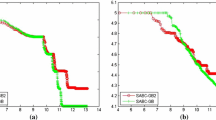Abstract
In this paper, an improved multi-objective ABC algorithm based on k-means clustering, called CMOABC, is proposed. For keeping the population diversity, the multi-swarm technology based on k-means clustering is employed to decompose the population into many clusters. Due to each subcomponent evolving separately, after every specific iterations, the population will be re-clustered to facilitate information exchange among different clusters. CMOABC is applied to solve the real-world Optimal Power Flow (OPF) problem that considers the cost, loss, and emission impacts as the objective functions. The simulation results demonstrate that, compared to NSGA-II, MOPSO, and MOABC, the proposed CMOABC is superior for solving OPF problem, in terms of optimization accuracy.
Access this chapter
Tax calculation will be finalised at checkout
Purchases are for personal use only
Similar content being viewed by others
References
Deb, K., Pratap, A., Agarwal, S., Meyarivan, T.: A fast and elitist multiobjective genetic algorithm: NSGA-II. IEEE Trans. Evol. Comput. 6(2), 182–197 (2002)
Coello, C.A.C., Pulido, G.T., Lechuga, M.S.: Handling multiple objectives with particle swarm optimization. IEEE Trans. Evol. Comput. 8(3), 256–279 (2004)
Zhang, Q., Liu, W., Li, H.: The performance of a new version of MOEA/D on CEC09 unconstrained MOP test instances. In: Proceedings of the Congress on Evolutionary Computation (CEC 2009), Norway, pp. 203–208 (2009)
Karaboga, D., Akay, B.: A comparative study of artificial bee colony algorithm. Appl. Math. Comput. 214, 108–132 (2009)
Omkar, S.N., Senthilnath, J., Khandelwal, R., Naik, G.N., Gopalakrishnan, S.: Artificial bee colony (ABC) for multi-objective design optimization of composite structures. Appl. Soft Comput. 11(1), 489–499 (2011)
Sivasubramani, S., Swarup, K.S.: Environmental/economic dispatch using multi-objective harmony search algorithm. Electr. Power Syst. Res. 81, 1778–1785 (2011)
El-Keib, A., Ma, H., Hart, J.: Economic dispatch in view of the clean air act of 1990. IEEE Trans. Power Syst. 9(2), 972–978 (1994)
Halder, U., Das, S., Maity, D.: A cluster-based differential evolution algorithm with external archive for optimization in dynamic environments. IEEE Trans. Cybern. 43(3), 881–897 (2013)
Song, T., Pan, Z., Wong, D.M., Wang, X.: Design of logic gates using spiking neural P systems with homogeneous neurons and astrocytes-like control. Inf. Sci. 372, 380–391 (2016)
Wang, X., Song, T., Gong, F., Pan, Z.: On the computational power of spiking neural P systems with self-organization. Sci. Rep. (2016). doi:10.1038/srep27624
Author information
Authors and Affiliations
Corresponding author
Editor information
Editors and Affiliations
Rights and permissions
Copyright information
© 2016 Springer Nature Singapore Pte Ltd.
About this paper
Cite this paper
Sun, L., Chen, H. (2016). Artificial Bee Colony Algorithm Based on Clustering Method and Its Application for Optimal Power Flow Problem. In: Gong, M., Pan, L., Song, T., Zhang, G. (eds) Bio-inspired Computing – Theories and Applications. BIC-TA 2016. Communications in Computer and Information Science, vol 682. Springer, Singapore. https://doi.org/10.1007/978-981-10-3614-9_13
Download citation
DOI: https://doi.org/10.1007/978-981-10-3614-9_13
Published:
Publisher Name: Springer, Singapore
Print ISBN: 978-981-10-3613-2
Online ISBN: 978-981-10-3614-9
eBook Packages: Computer ScienceComputer Science (R0)




